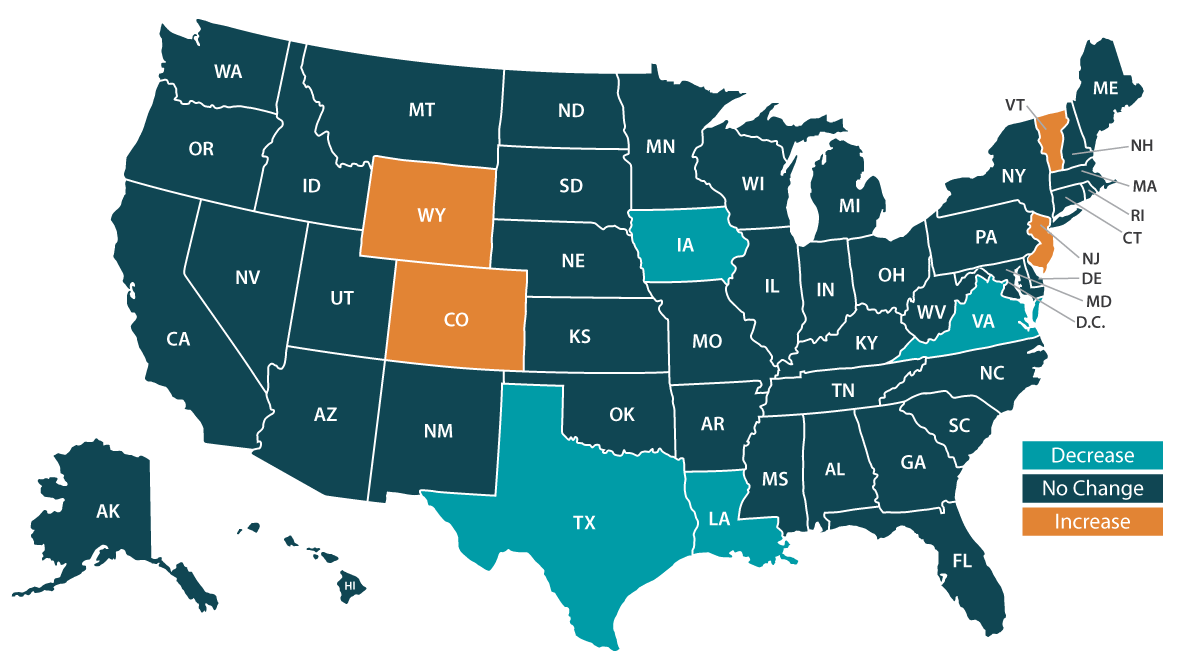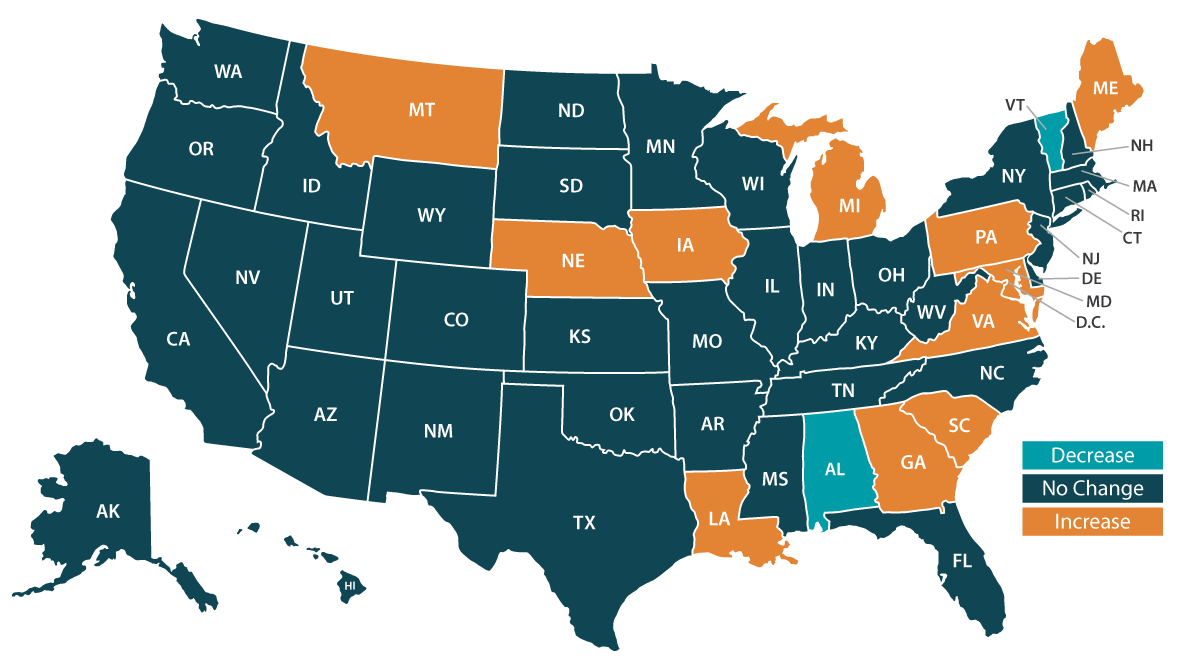Blog & News
2018 ACS: Private Coverage Changes Split Evenly among States, Public Coverage Changes Experience Greater Variability than in 2017
September 26, 2019:The U.S. Census Bureau released partial state files for the 2018 American Community Survey (ACS) today, which included state-level information about health insurance coverage by coverage type.
The State Story
The overall national decrease in insurance coverage in 2018 (from 91.3% in 2017 to 91.1% last year) was mirrored by significant overall coverage decreases in eight states, although three states did see significant increases in coverage. There was variation among states in the extent to which there were changes in rates of public and private coverage in particular, and in whether these changes represented increases or decreases.
Private Coverage Rates by State, All Ages, 2017-2018: As Many States (Four) Saw Increases as Saw Decreases (Four)
- Four states (Colorado, New Hampshire, Vermont, and Wyoming) experienced significant increases in private coverage rates in 2018, echoing a similar trend in 2017, when private coverage increased significantly in just three states. Vermont saw the largest increase in private coverage from 2017 to 2018, growing by 3.4 percentage points, from 66.5% to 69.9%.
- Private coverage decreased significantly also in just four states from 2017 to 2018 (Iowa, Louisiana, Texas, and Virginia), a decrease from 2017, when ten states experienced significant decreases in private coverage. Louisiana saw the largest 2018 decrease in private coverage, with its rate falling 1.2 percentage points, from 60.3% to 59.1%.
- 42 states (including D.C.) experienced no significant change in rates of private coverage from 2017 to 2018.[1]
Public Coverage Rates by State, All Ages, 2017-2018: 11 States Saw Increases while Two States Saw Decreases
- There were more changes in public coverage rates than private coverage rates in 2018. Thirteen states saw significant changes from 2017 to 2018, as public coverage increased significantly in 11 states (Georgia, Iowa, Louisiana, Maine, Maryland, Michigan, Montana, Nebraska, Pennsylvania, South Carolina, and Virginia), and decreased significantly in two states (Alabama and Vermont). There were more state increases between 2017 and 2018 (11 states) than between 2016 and 2017 (eight states), and there were fewer state decreases between 2017 and 2018 (two states) than between 2016 and 2017 (four states).
- Louisiana saw the largest percentage-point increase (1.8 percentage points) in public coverage in 2018, rising from 42.6% to 44.4%.
- Vermont had the largest drop in public coverage, decreasing 3.6 percentage points from 44.4% to 40.6%.
- 37 states (including D.C.) saw no change in public coverage rates in 2018.[1]
Access the 2018 ACS 1-year tables here.
More to Come
This year’s data release of health insurance coverage estimates from the Current Population Survey (CPS) and American Community Survey (ACS) has been staggered, with nationwide uninsurance data from the CPS and ACS released on September 10th, estimates by coverage type at the national and state level released today, September 26th, and further state-level breakdowns by age, race/ethnicity, education level, and more, will be available next month on October 17th. Stay tuned for more granular details about insurance coverage changes in the states from 2017 to 2018 via customized SHADAC tables examining coverage at the state and county level.
Related Reading
Census Bureau Experts Will Share Insights during October 1st Webinar
At noon on Tuesday, October 1st, SHADAC will host a webinar to examine the new 2018 ACS and CPS estimates, with technical insight provided by researchers from SHADAC and from the U.S. Census Bureau, which administers both surveys.
Speakers will discuss the new 2018 national and state estimates, and attendees will learn:
- When to use which estimates from which survey
- How to access the estimates via Census reports and the new dissemination site: data.census.gov (replacing the now-retired American FactFinder)
- How to access state-level estimates from the ACS using SHADAC tables
Attendees will have an opportunity to ask questions after the speaker presentations.
Notes
All changes described in this document are significant at the 90% level. All estimates are for all ages. Private coverage includes individually purchased and employer-sponsored coverage.
[1] Estimates in both private and public coverage were not available for Delaware in 2017, so this state has not been counted in any category as there is no way to measure a year-over-year change.
Blog & News
Updated Health Insurance Coverage Estimates Available for All U.S. Counties
January 14, 2019:SHADAC tables of state and county uninsurance estimates for 2013 to 2017 are now available via clickable map. Users can click a state to access a table of 5-year uninsurance estimates for each state as a whole, as well as all counties located within, using data from the American Community Survey (ACS).
The 5-year ACS is created by pooling together five years of ACS data to produce estimates for areas and subgroups with smaller populations. With the 5-year pooled data, estimates are available even for counties with a population below 65,000 (for which estimates are not available with just a single year of ACS data).
Publication
State and County Coverage Estimates, 2013-2017 ACS
Use this clickable map to see health insurance coverage estimates for each state and all counties for the pooled years 2013-2017.
Counties are searchable by bookmark in each state file.
2013-2017 American Community Survey (ACS) 5-Year Estimates:
Percent Uninsured, Total Civilian Noninstitutionalized Population by County
Click here to view estimates for Puerto Rico by municipio.
Click here to view a 50-state table of estimates.
These estimates come from the 5-year American Community Survey (ACS) via the U.S. Census Bureau’s American FactFinder (AFF) tool. The 5-year ACS is created by pooling together five years of ACS data to produce estimates for areas and subgroups with smaller populations.
About the ACS
The ACS is a household survey that began in 2005 and produces annually updated data on a variety of population characteristics, including health insurance coverage. In total, the ACS surveys approximately three million US households each year. An important feature of the ACS is that it includes a large enough sample for state‐level and sub‐state estimates.
The Census Bureau publishes 1-year estimates for areas with populations of 65,000 or more and 5-year estimates (covering 60 months) for all statistical, legal, and administrative entities.
The ACS began asking survey respondents about health insurance coverage during the 2008 calendar year. Specifically, the survey asks respondents about current coverage for each person in the respondent’s household. A person is categorized as “insured” if he or she has coverage at the point in time at which the survey is administered.
How Are these Estimates Different from the Estimates that SHADAC Publishes Using Census Bureau Micro-Data Files?
Two definitions used by the Census Bureau to generate the tabulations above differ from those that SHADAC uses to generate tabulations for State Health Compare. The definitional differences are as follows:
Family
- The Census Bureau defines a family as all related people in a household.
- SHADAC defines a family using a measure called the “Health Insurance Unit” (HIU), which includes all individuals who would likely be considered a family unit in determining eligibility for either private or public coverage.
- To learn more about the HIU, see SHADAC Brief #27, “Defining Family for Studies of Health Insurance Coverage.”
Family Income
- The Census Bureau determines family income as a percentage of the Federal Poverty Level (FPL), which is a definition of poverty used primarily for statistical purposes. For example, FPL is used to estimate the number of Americans living in poverty each year.
- SHADAC determines family income as a percentage of the U.S. Department of Health and Human Services’ Federal Poverty Guidelines (FPG), which is a measure used for administrative purposes. For example, FPG is used to determine eligibility for federal programs such as Medicaid and the Supplemental Nutrition Assistance Program (SNAP).
- To learn more about the difference between FPL and FPG, click here.
SHADAC Expertise
AMERICAN COMMUNITY SURVEY
The American Community Survey (ACS) is a general household survey conducted by the U.S. Census Bureau that includes data on income, poverty, disability, marital status, education, occupation, travel to work, and disability, health insurance coverage, among other topics. An important feature of the ACS is that it includes a large enough sample for state-level and sub-state estimates including estimates of insurance coverage. The ACS has asked about health insurance coverage since 2008, inquiring about coverage for each person in the household separately. Respondents can indicate more than one type of coverage. SHADAC uses American Community Survey data to analyze and understand coverage, health disparities, and more in the United States.
Learn more about the detailed codes and definitions for variables, statistical testing, and an explanation of sample design, methodology, and accuracy for the American Community Survey on the U.S. Census Bureau’s website.
American Community Survey Estimates
The ACS health insurance estimates are available through summary tabulations, downloads of microdata, and restricted-use files.
Restricted Use Files
ACS Summary Tabulations
SHADAC's State Health Compare provides summary tabulations of ACS estimates from 2008 to the present for select measures. State Health Compare is a user-friendly tool for obtaining state-level estimates related to health and healthcare.
Please visit American Factfinder (AFF) or data.census.gov for data tables based on the full file that include all topics available in the ACS.
ACS Microdata
Microdata are available using the Public Use Microdata Sample (PUMS) or the full file. The PUMS, which are available directly through the Census Bureau or from a few third party data access sites, include a sample of the full ACS (about 67% of records). SHADAC recommends accessing public use microdata from the Integrated Public Use Microdata Series (IPUMS).
The full ACS file is a restricted-use file available only at a Census Research Data Center (RDC). Users must submit an application to use an RDC and, once approved, travel to the RDC to conduct the research. The University of Minnesota houses an RDC (MNRDC) and SHADAC will work with state health policy analysts who are interested in using this facility. Feel free to contact SHADAC to discuss your MNRDC needs.
ACS Resources
Comprehensive documentation on the ACS is available at the Census Bureau's ACS web page. SHADAC also has a variety of annually-updated resources related to the measurement of health insurance coverage that can be found here.
Please sign up for our mailing list to be notified about future annual data release data and products.
Publication
Demographic, Social, and Economic Characteristics of the General Population of Minnesotans aged 65 and Older
As part of a suite of studies titled: Own Your Future 3.0: Planning for Minnesotans' LTSS Needs, sponsored by Minnesota’s Department of Human Services and Board on Aging, this report summarizes the demographic, social, and economic characteristics of Minnesotans aged 65 and older using data from the 2019 U.S. American Community Survey (ACS). It compares the Medicaid population to the non-Medicaid Minnesota population; and compares the characteristics of Minnesota’s elderly population (both Medicaid and non-Medicaid) to the U.S. population.














